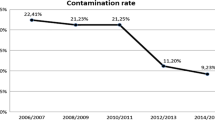Abstract
Iranian Tissue Bank established in 1994 provides soft tissues for implantation in Iran. This study was designed to evaluate the efficacy of decontamination process of cardiac and soft tissues in Iranian Tissue Bank. In this bank after initial assessments, the tissues were incubated in a 5-antibiotic cocktail at room temperature for 24 h and then at 4 °C for 14 days. Contamination status was compared before and after antibiotic cocktail incubation. Of 3,315 assessed tissues, 1,057 were pericardia, 1,051 were fascia and 1,207 were other soft tissues including tibialis and aorta. The initial contamination rate was 36.86 %. Pericardia showed the highest contamination rate. Klebsiella species was the most prevalent organism causing contamination. Decontamination rate after antibiotic incubation was 86.91 % with the highest successful decontamination rate for fascia tissue. Klebsiella species was the major source of contamination in tissues that remained contaminated after antibiotic incubation. This may be due to resistance of this organism to applied antibiotics in the decontamination cocktail possibly due to a negative drug interaction between aminoglycoside and penicillin derivatives in this antibiotic cocktail. In conclusion collected data shows comparable efficacy of the decontamination process that is used in ITB compared with homograft banks of other countries.





Similar content being viewed by others
References
American Association of Tissue Bank (2008) Standards for tissue banking, 12th edn. AATB, Mclean
Angell JD, Christopher BS, Hawtrey O, Angell WM (1976) A fresh, viable human heart valve bank: sterilization, sterility testing and cryogenic preservation. Transplant Proc 8:139–147
Arjmand B, Aghayan SH, Goodarzi P, Farzanekhah M, Mortazavi SM, Niknam MH, Jafarian A, Arjmand F, Jebbelyfar S (2009) Seroprevalnece of human T lymphtropic virus (HTLV) among tissue donors in Iranian Tissue Bank. Cell Tissue Bank 10:247–252. doi:10.1007/s10561-008-9117-9
Barratt-Boyes BG, Roche AH, Subramanyan R, Pemberton JR, Whitlock RM (1987) Long-term follow-up of patients with the antibiotic-sterilized aortic homograft valve inserted free hand in the aortic position. Circulation 75:768–777
Brayfield A (2014) Martindale: the complete drug reference. Pharmaceutical Press, London
Coraça-Huber DC, Hausdorfer J, Fille M, Steidl M, Nogler M (2013) Effect of two cleaning processes for bone allografts on gentamicin impregnation and in vitro antibiotic release. Cell Tissue Bank 14:221–229. doi:10.1007/s10561-012-9314-4
de By TMMH, Parker R, Delmo Walter EM, Hetzer R (2012) Cardiovascular tissue banking in Europe. HSR Proc Intensive Care Cardiovasc Anesth 4:251–260
Eagle H, Musselman AD (1998) The rate of bactericidal action of penicillin in vitro as a function of its concentration and its paradoxically reduced activity at high concentrations against certain organisms. J Exp Med 88:99–131
Fan YD, Van-Hoeck B, Holovska V, Jashari R (2012) Evaluation of decontamination process of heart valve and artery tissues in European Homograft Bank (EHB): a retrospective study of 1,055 cases. Cell Tissue Bank 13:297–304. doi:10.1007/s10561-011-9255-3
Gall K, Smith S, Willmette C, Wong M, O’Brien M (1995) Allograft heart valve sterilization: a six-year in-depth analysis of a twenty-five-year experience with low-dose antibiotics. J Thorac Cardiovasc Surg 110:680–687
Germian J, Thibault L, Jacques A, Tremblag J, Bourgeois R (2010) Heart valve allograft decontamination with antibiotics: impact of the temperature of incubation on efficacy. Cell Tissue Bank 11:197–204
Heng WL, Seck T, Tay CP, Chua A, Song C, Lim CH, Lim Y (2013) Homograft banking in Singapore: two years of cardiovascular tissue banking in Southeast Asia. Cell Tissue Bank 14:187–194. doi:10.1007/s10561-012-9310-8
Ireland L, Spelman D (2005) Bacterial contamination of tissue allografts—experiences of the donor tissue bank of Victoria. Cell Tissue Bank 6:181–189
Jashari R, Tabaku M, Van Hoeck B, Coche´z C, Vanderkelen A (2007) Decontamination of heart valve and arterial allografts in the European Homograft Bank (EHB): comparison of two different antibiotic cocktails in low temperature conditions. Cell Tissue Bank 8:247–255
Kealey PG (1997) Disease transmission by means of allograft. J Burn Care Rehabil 18:s10–s11
Kirklin JW, Blackstone EH, Maehara T, Pacifico AD, Kirklin JK, Pollock S, Stewart RW (1987) Intermediate-term fate of cryopreserved allograft and xenograft valved conduits. Ann Thorac Surg 44:598–606
Pitt TL, Tidey K, Roy A, Ancliff S, Lomas R, McDonald CP (2014) Activity of four antimicrobial cocktails for tissue allograft decontamination against bacteria and Candida spp. of know susceptibility at different temperatures. Cell Tissue Bank 15:119–125
Stolinski J, Marek G, Marcinkowska Z, Jaskier M, Barecka D, Bartus K, Kapelak B, Sadowski J, Dziatkowiak A (2006) Allogenic heart valve bank in the Department of Cardiovascular Surgery and Transplantology of Jagiellonian University in Cracow—23 years experience in the treatment of aortic valve or aortic valve or aortic root diseases. Cell Tissue Bank 7:175–182
Strickett M, Barratt-Boyes B, MacCulloch D (2010) Disinfection of human heart valve allografts with antibiotics in low concentration. Pathology 15:457–462
Tabaku M, Jashari r, Carton HF, Du verger A, Van Hoeck B, Vanderkelen A (2004) Processing of cardiovascular allografts: effectiveness of European Homograft Bank (EHB) antimicrobial treatment (cool decontamination protocol with low concentration of antibiotics). Cell Tissue Bank 5:261–266
Trissel LA (2013) Handbook of injectable drugs. ASHP, Maryland
van Kats J, van Tricht C, van Dijk A, van der Schans M, van den Bogaerdt A, Petit P, Bogers A (2010) Microbiological examination of donated human cardiac tissue in heart valve banking. Eur J Cardiothorac Surg 37:163–169
Winklera H, Janatab O, Bergera C, Weinc W, Georgopoulosd A (2000) In vitro release of vancomycin and tobramycin from impregnated human and bovine bone grafts. J Antimicro Chemother 46:423–428
Acknowledgments
This study was part of a PharmD thesis supported by Tehran University of Medical Sciences. The authors express their gratitude to staffs of ITB who dedicatedly helped us in this study.
Conflict of interest
All authors declare no conflict of interest.
Author information
Authors and Affiliations
Corresponding author
Rights and permissions
About this article
Cite this article
Dashti-Khavidaki, S., Dabardani, F., Mahdavi-Mazdeh, M. et al. Efficacy of decontamination protocol by antimicrobial treatment in Iranian Tissue Bank (ITB). Cell Tissue Bank 16, 381–388 (2015). https://doi.org/10.1007/s10561-014-9482-5
Received:
Accepted:
Published:
Issue Date:
DOI: https://doi.org/10.1007/s10561-014-9482-5




